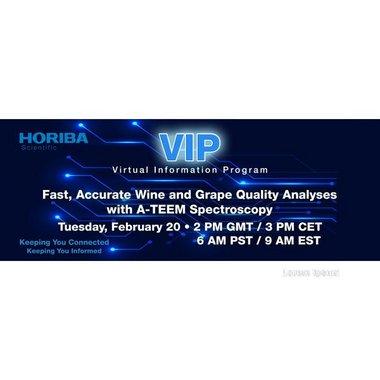Event
Beginning: 02/20/24
Location: Online
Tuesday, February 20 at 3 p.m. CET, 2 p.m. GMT, 9 a.m EST / 6 a.m PST
Overview:
Rapid grape and wine quality analyses are becoming more important to the wine industry. Conventional chromatographic and wet-chemistry assays can be expensive and limit acquisition and dissemination of key information regarding ripening, harvesting and processing grapes for wine production. HORIBA’s patented optical method, Absorbance-Transmittance fluorescence Excitation Emission matrix (A-TEEM) spectroscopy can facilitate rapid, accurate results comparable to traditional analytical techniques. A-TEEM is simple, fast and requires minimal sample preparation.
This presentation summarizes exciting new results including accurate quantification of phenolic and anthocyanin compounds, tannins, oak and smoke volatiles and glycoconjugates as well as pH, sulfites and several other basic chemistry parameters in a single scan. We also present data on authentication of grape varieties, blending and (sub-) regions, as well as detecting contamination and taint effects including those associated with Brettanomyces sp. and smoke exposure.
What you will learn:
- What is A-TEEM spectroscopy and how does it compare to other optical and chromatographic methods?
- What are the key quality parameters important to grape processing for winemaking.
- What is the significance of grape varietal, regional and blending authentication.
- What is the significance of Brettanomyces contamination and smoke exposure for wine processing.
- How to prepare and analyze grape and wine samples for A-TEEM spectroscopy including automation.
- How to automate A-TEEM data reporting and facilitate transmission to key stakeholders (growers and winemakers).
Who should attend:
- Wine industry professionals including laboratory managers and operators as well as Research and Development scientists.
- Academic researchers and students in the areas of viticulture and enology interested in grape and wine chemical analyses.
- Researchers in food and beverage industry facing similar analytical challenges to those in the wine industry for natural product chemical analysis and quality characterization.

